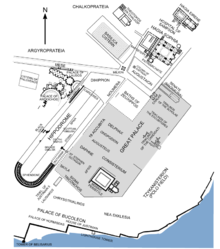Basilica Cistern
The cistern, located 150 metres (490 ft) southwest of the Hagia Sophia on the historical peninsula of Sarayburnu, was built in the 6th century during the reign of Byzantine emperor Justinian I.
Ancient texts indicated that the basilica cistern contained gardens surrounded by a colonnade that faced the Hagia Sophia.
The existence of the cistern was eventually forgotten by all but the locals who still drew water from it until, in 1565, the French traveller Petrus Gyllius left a record of it.
The majority of the columns in the cistern appear to have been recycled from the ruins of older buildings (a process called 'spoliation'), likely brought to Constantinople from various parts of the empire, together with those that were used in the construction of Hagia Sophia.
[1] Fifty-two stone steps descend into the cistern which is surrounded by a firebrick wall with a thickness of 4 metres (13 ft) and coated with a waterproofing mortar.
[1] The weight of the cistern is carried on the columns by means of the cross-shaped vaults and round arches of its roof.
The first repairs were carried out in the 18th century during the reign of the Ottoman sultan Ahmed III in 1723 by the architect Muhammad Ağa of Kayseri.
[8] The origin of the two heads is unknown, though it is thought that they were brought to the cistern after being removed from a building of the late Roman period.
The cistern plays a key role in Dorothy Dunnett's historical novel Pawn in Frankincense (1969), fourth volume of The Lymond Chronicles.

